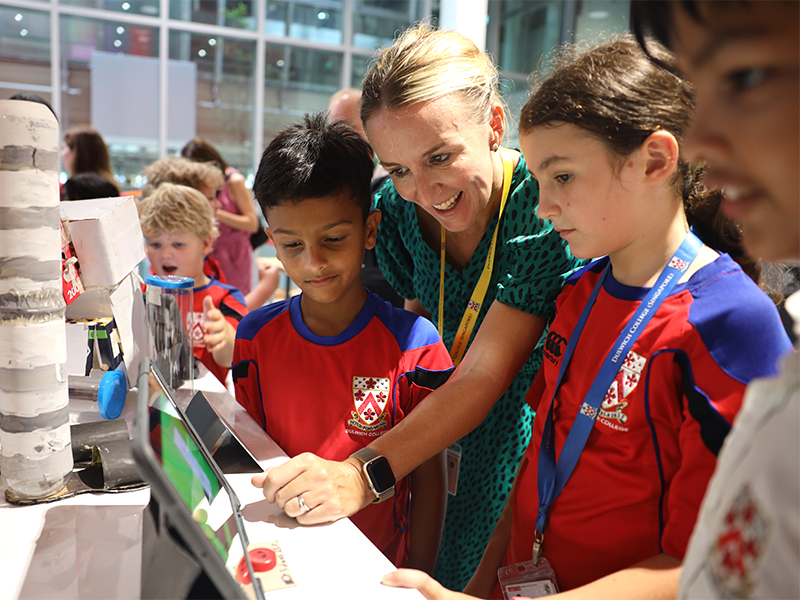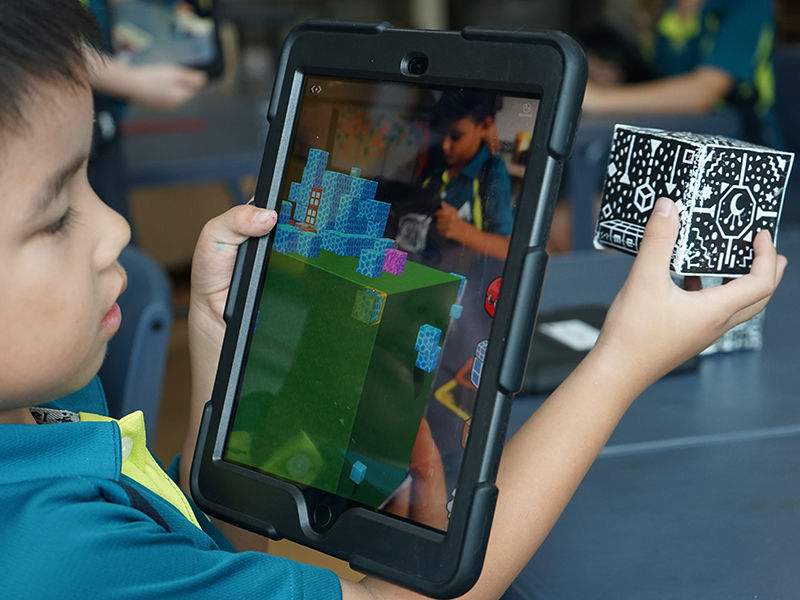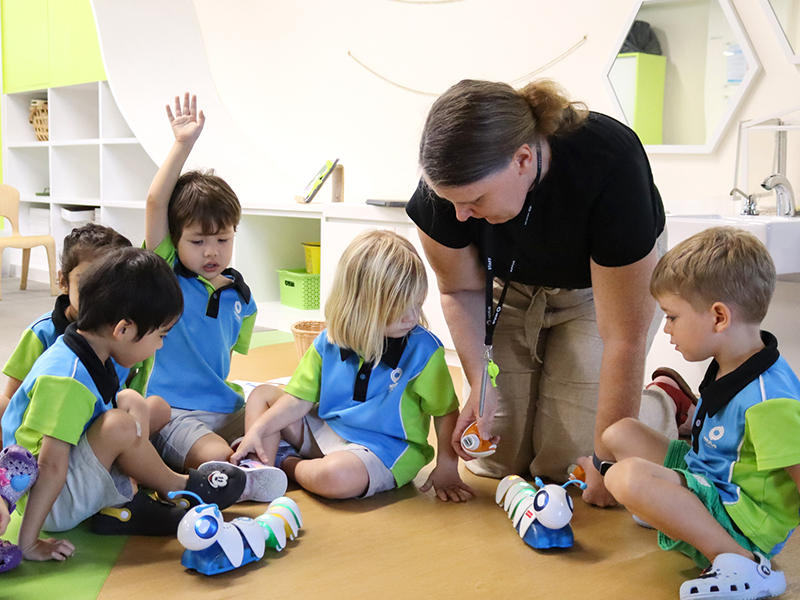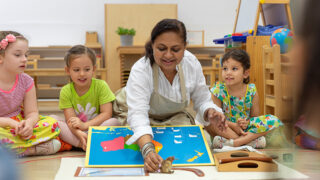Digital learning at international schools has become more popular and essential. Educational technology can be incredibly helpful for both teaching and learning. How is it used? Examples include to support learning in academics, and in school projects, outdoor expeditions and other activities. We take a look at how students are developing 21st-century skills at these Singapore international schools that carry out learning via technology.
One World International School Digital Campus in Punggol
While maintaining a dedication to traditional learning involving the usage of pen and paper, the One World International School (OWIS) Digital Campus places a strong emphasis on a technologically enhanced educational approach, fostering digital literacy and citizenship skills among learners. The school says that educational technology is seamlessly integrated into every corner and aspect of the campus, enhancing the digital learning experience from Early Childhood to Primary and Secondary Schools.

The school offers 63 skills studios – 22 studios at OWIS and 41 shared studios – where students engage in a wide range of activities that enhance both their technical and creative skills. For instance, they learn coding and engineering, which develop their computational thinking and problem-solving skills. They also extend their creative talents by exploring graphics, video editing and sound mixing.
Classrooms are equipped with smart devices including smart boards, all of which enable greater interactivity during lessons. Teachers and students can use their smart devices to project content on the interactive LED touchscreens for a more engaging learning experience. Additionally, the campus has a world-class sports arena. Soon, there will be a Sports Performance Enhancing Data Analytics System installed. This will capture on-field performance data to help players and coaches improve sporting performance.
Within this future-focused environment, students cultivate 21st-century skills such as critical thinking, creativity, collaboration and communication. The OWIS teams says that these skills empower them to be responsible and knowledgeable digital citizens, capable of navigating today’s dynamic world with confidence.
#01-02 Global Campus Village, 27 Punggol Field Walk
6914 7351 | owis.org/punggol-digital-campus
Educational technology at Dulwich College (Singapore)
Creative thinking drives the use of educational technology at Dulwich. The school’s vision is to develop well-rounded and balanced students who are proficient in both online and offline environments. Students build on a core foundation of academic skills, including being able to write by hand. These are enhanced with technology; by also building a core foundation of digital literacy skills, students develop the agility required to take advantage of emerging new technologies.
The strategic and purposeful use of portable devices within the classroom at Dulwich allows children to independently engage in digital learning at school in different ways, using a range of media, applications, augmented reality and pen-enabled technology. In Kindergarten and Junior School, children have access to a wide range of school-owned devices and applications. As the students grow in independence and proficiency and transition into Senior School, they bring their own devices. In time, students become confident, competent and responsible digital citizens who can enhance their own learning using technology skills, their own lives and the lives of others.
71 Bukit Batok West Avenue 8
6890 1000 | singapore.dulwich.org
Australian International School technology integration
Technology is seamlessly integrated across every year level, department and area of the Australian International School in Singapore. This forms three pillars of technology integration under the initiative of Building A Community of Innovative Thinkers:
- An Intelligent Ecosystem prioritises cross-functionality and synchronisation for maximising efficiency and streamlining systems for enhanced productivity and cohesiveness.
- Innovative Learning for Staff and Students targets technology adoption and upskilling that complements existing programmes for staff and students.
- Innovative Spaces for Innovation creates dedicated areas throughout the school. At the same time, every classroom is transformed into an innovative digital learning space that empower students and teachers to effectively utilise technology to enhance learning.
The classrooms and dedicated technology rooms called Innovation Labs are key technologies. These include AR/VR headsets and platforms, robotics and coding kits, 3D printers and modelling software, interactive whiteboards and smart displays, online learning platforms and virtual classrooms, STEM kits and equipment, and multimedia production tools. This approach to educational technology empowers both staff and students. They become productive, creative and innovative in their everyday teaching and learning practices, and building 21st century skills.
1 Lorong Chuan
6653 2958 | ais.com.sg
Digital learning at Nexus International School (Singapore)
At Nexus, educational technology is used to enhance the learning process, capture interest and improve engagement in the classroom. Nexus is also the first school in Asia to incorporate Brain Fitness into its curriculum. It’s a gamified learning experience that improves cognitive performance.
Digital learning is incorporated into every stage of the curriculum. For instance, in recent classes:
- Year 2s measured light with mini-computers
- Year 3s created multimedia books on iPads
- Year 4s interviewed the owner of a sustainable fashion company in New Zealand via video call
- Year 5s generated images through artificial intelligence,
- Year 6s engaged with customised ChatBots to refine their inquiry skills for the PYP exhibition.
Learners in Years 3 to 6 have regular digital skills classes. In these, they develop a fundamental understanding of basic coding concepts, includign creating sequences, using loops and applying conditional logic to solve problems.
From Year 5 onwards, every learner is equipped with their own iPad or MacBook. They use this to conduct research and collaborate with peers. Teachers share up-to-date feedback with learners through apps such as Seesaw and Canvas. Parents can also use the apps to see their child’s daily progress and initiate conversations with their children about learning and school life. Beyond the classroom, learners in the Middle Years Program and IB Diploma use iPads to capture and edit key moments during field trips, science experiments and also film presentations. These multimedia learning aids reinforce understanding and boost creativity.
Interactive lessons, simulations, readily available online resources and Augmented Reality (AR) allow Nexus teachers to tailor their digital learning approach to individual learning styles and paces. Learners might find themselves dissecting a virtual frog for biology, for example, or exploring the pyramids of Egypt for history, all within the walls of the classroom. The school says this personalised approach empowers students to become self-directed learners; as they navigate digital resources, Nexus learners are equipped with essential 21st-century skills that are crucial for success, and they learn how to use technology ethically.
1 Aljunied Walk
6536 6566 | nexus.edu.sg
Read on for summer holiday camps that the kids will love. We also have the best things to do in Singapore with kids!
To make the most of living in Singapore, read our latest City Guide here for free!








